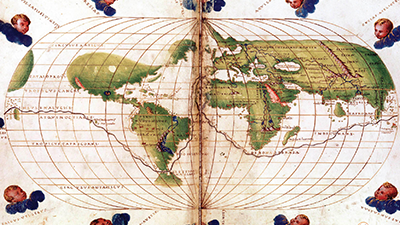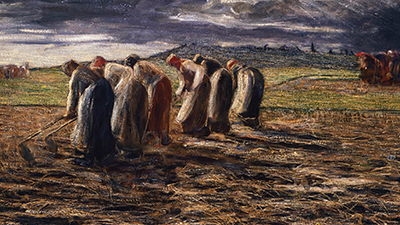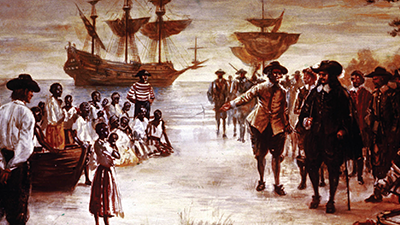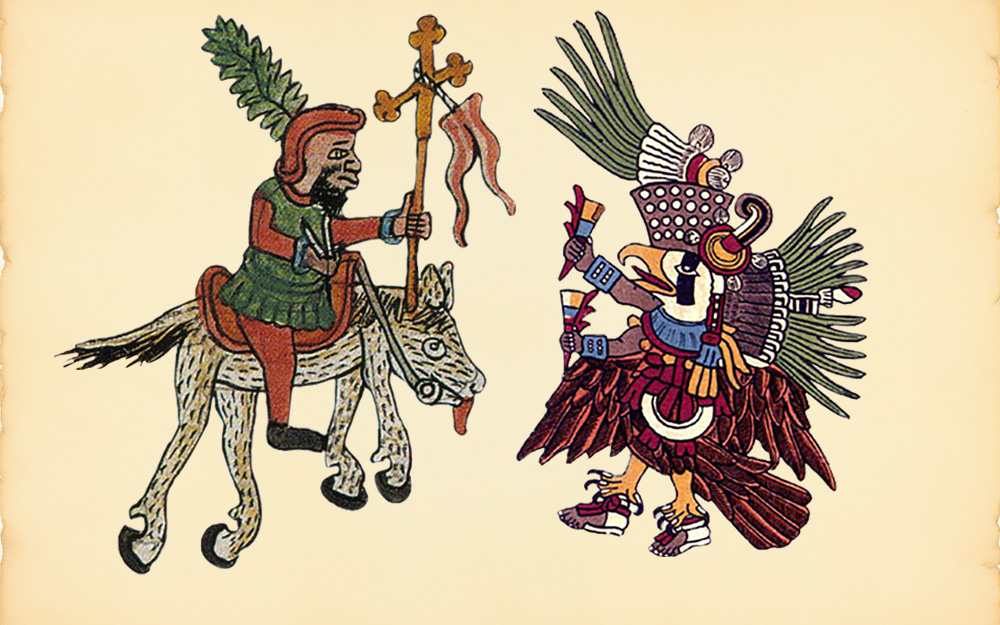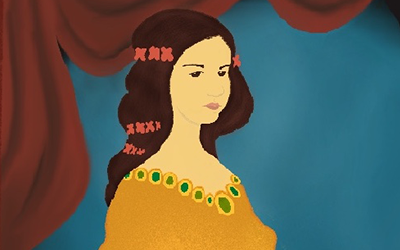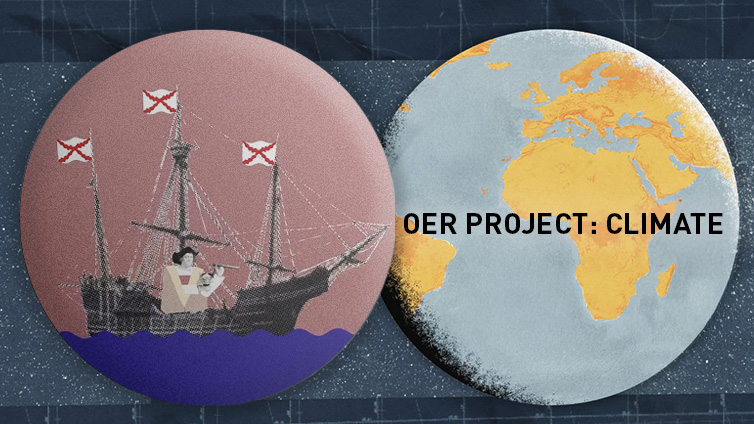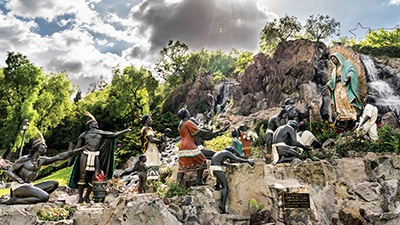The Columbian Exchange
Driving Question: What were the causes of the Columbian Exchange, and what impacts did it have on the Eastern and Western Hemispheres?
There were complex networks of exchange long before Columbus reached the so-called New World. These networks were, of course, not old to the millions of Indigenous Americans who lived there. But the new connections between Afro-Eurasia and the Americas created a truly global network that would forever alter the world’s people, plants, and animals.
Learning Objectives
- Explain the causes of the Columbian Exchange and its effects on the Eastern and Western Hemispheres.
- Use the historical reasoning process of sourcing to evaluate the Spanish conquest of the Aztec Empire from two different perspectives.
- Assess the environmental and cultural effects of the Columbian Exchange on Afro-Eurasia and the Americas.
Vocab Terms:
- cash crop
- demographic
- enslave
- epidemic
- indigenous
- plantation system
- staple crop
Opener: Columbian Exchange
To teach this lesson step, refer to page 3 of the Lesson 4.3 Teaching Guide.
Our Interconnected World is a teacher favorite at OER Project. Explore teaching tips and see real classroom photos in the Community Forum.
The world changed radically after 1450—but how? And why?
The Columbian Exchange
To teach this lesson step, refer to page 7 of the Lesson 4.3 Teaching Guide.
Want to dive deeper into the Columbian Exchange? Download detailed OER Project maps here.
The arrival of Columbus in the New World changed everything, from the way people ate to the diseases they carried.
-
Guiding Questions
-
Before you read
Preview the questions below, and then skim the article. Be sure to look at the section headings and any images.
While you read
Look for answers to these questions:
- What were Indigenous communities in the Americas like before the Columbian Exchange?
- Why were Indigenous Americans so vulnerable to diseases?
- How did epidemic diseases affect the environment and the economy?
- What animals were domesticated by humans in the Americas, before and after the Columbian Exchange?
After you read
Respond to the following questions:
- To what extent does this article explain the causes of the Columbian Exchange and its effects on the Eastern and Western Hemispheres?
- The author of this article argues that the “Columbian Exchange completely changed the face of the world.” Based on the evidence in this article, do you agree with this assessment? Why or why not?
Primary Source Preview
The horror people endured in the transatlantic slave trade is beyond imagining. Reading the words written by those who survived can help you begin to understand.
Crops that Grew the World
To teach this lesson step, refer to page 8 of the Lesson 4.3 Teaching Guide.
Humans have always moved plants and animals around with us. But after 1500, a biological exchange between the Old World and the New changed populations, trade networks, cultures, and environments around the globe forever.
-
Guiding Questions
-
Before you read
Preview the questions below, and then skim the article. Be sure to look at the section headings and any images.
While you read
Look for answers to these questions:
- What’s the difference between a staple crop and a cash crop? What different economic effects did they have?
- How did European plantation owners maximize their profits?
- In what ways did European colonists impact exchange networks and the global production and distribution of goods?
- How did European use of crops and animals affect the environment in the Americas?
- What effect did the introduction of the potato have on European populations? How did this change over time?
After you read
Respond to the following questions:
- What evidence does this article provide to explain the causes of the Columbian Exchange and its effects on the Eastern and Western Hemispheres?
- In the article, the author cites Crosby’s argument that the most important change brought about by the European conquests was not political but biological. With the information you currently have, do you find the author’s argument convincing? Why or why not?
The Disastrous Effects of Increased Global Interactions c. 1500 to 1600
To teach this lesson step, refer to page 10 of the Lesson 4.3 Teaching Guide.
Parts of the world benefitted by increased global networks. But the Atlantic slaving system as well as the sharp decline in indigenous populations in certain regions were among the devastating effects of this period.
-
Guiding Questions
-
Before you read
Preview the questions below, and then skim the article. Be sure to look at the section headings and any images.
While you read
Look for answers to these questions:
- Why is it difficult for historians to determine the scale of the Great Dying?
- What groups of people migrated to the Americas involuntarily?
- What do the categories “mestizo” and “mulatto” mean? Who came up with these categories?
- How did the population of sub-Saharan Africa change as a result of the Columbian Exchange?
- What was the plantation complex? Whom did it benefit?
After you read
Respond to the following question:
- The author claims that “demographic changes in both the Americas and Africa were mostly disastrous for indigenous peoples. European economies and communities were the ones that mostly benefitted from their arrival in the Americas and from the Atlantic slave trade network.” Using this article and other articles and videos in this lesson, find evidence that supports, extends, or challenges this claim.
Primary Source Reflection
Now that you’ve learned more about the transatlantic slave trade, reflect on what you’ve learned and how it informs your life today.
Sourcing: Spanish Conquest of the Aztec Empire
To teach this lesson step, refer to page 11 of the Lesson 4.3 Teaching Guide.
For more on the Aztec Perspective, check out this thread in the Community Forum.
It may not be surprising to learn that there are differing perspectives when it comes to the Spanish conquest of the Aztec Empire. Analyze the words of an Aztec poem to that of Spanish conquistador Hernán Cortés to come to a deeper understanding of this event.
Graphic Biography: Sor Juana Inés de la Cruz
To teach this lesson step, refer to page 15 of the Lesson 4.3 Teaching Guide.
Help your students unlock the world of graphic biographies with the Three-Step Reading Guide for Graphic Biographies.
Colonial society in the Americas had a reputation for being strictly hierarchical, with race playing a big role in who held power, while rigid gender roles limited opportunities for women. The story of Sor Juana Inés de la Cruz suggests things were sometimes a bit more complex.
-
Guiding Questions
-
Before you read
Preview the questions below, and then skim the comic, paying attention to things like prominent colors, shapes, and types of text and fonts. How do you know where to start and in which direction to read? What’s in the gutters (the space between panels)? Who or what is the focus of the comic?
While you read
Look for answers to these questions:
- When and where was Sor Juana Inés de la Cruz born?
- When Juana was a young girl, what did she first learn?
- Where was Juana working and living when she was seventeen years old? What controversial writing did she complete at this time?
- What decision did Juana make so that she could continue studying? How did this decision cause problems for her later?
- How does the artwork help us to understand the unique circumstances that shaped Juana’s life, particularly her dual heritage?
After you read
Respond to the following questions:
- Using evidence from this graphic biography, explain how Sor Juana’s story supports, extends, or challenges the social categories and roles you’ve learned about in this era.
- What evidence does Sor Juana’s biography provide about how people lived in the colonial Americas in this period? How does this evidence support, extend, or challenge what you have learned about the impact of the Columbian Exchange in this region?
Closer: Columbian Exchange
Human vs. AI Research Battle: The Significance of Foods
- Have students list foods that spread during the Columbian Exchange, then prompt AI to expand it.
- Then, have students ask AI which one food had the greatest historical impact.
- Finally, challenge students to do some of their own research to evaluate and critique the AI response.
What makes this effective? Students get to learn about historical significance using AI as a research partner. But rather than simply accepting the AI results, they use their own research to challenge or confirm its responses using evidence they gather, providing a valuable exercise in information literacy.
Would our eating patterns be completely different had it not been for the Columbian Exchange? Let’s find out by creating a menu that reflects life before and after the Columbian Exchange!
Transforming Environments
What does the Columbian Exchange have to do with modern climate change? Explore how this exchange transformed environments in ways we are still feeling today.
Religious Syncretism in Colonial Mexico City
To teach this lesson step, refer to page 17 of the Lesson 4.3 Teaching Guide.
The 1500s saw an interaction of religions in Mexico City as a result of Spanish control—but just how well did they blend?
-
Guiding Questions
-
Before you read
Preview the questions below, and then skim the article. Be sure to look at the section headings and any images.
While you read
Look for answers to these questions:
- What were the differences between Spanish conquistadors and missionaries?
- What were some reasons the Spanish were so eager to get people to convert religion?
- What were some strategies used by the Spanish to try to convert the indigenous population?
- What were some things that motivated some Aztecs to convert?
- How is the Lady of Guadalupe an example of religious syncretism, according to the author?
After you read
Respond to the following questions:
- How did cultural factors affect societies from 1450 to 1750?
- This article focuses on how religious syncretism shaped cultures. What are some ways that cultural developments and interactions likely played a role in the religious conversion of Mesoamerican indigenous communities?
- This article makes the point that the Columbian Exchange wasn’t just a biological exchange but also a cultural exchange. Can you think of any ways that the biological exchange of plants, animals, and people also created cultural shifts in different parts of the world?


